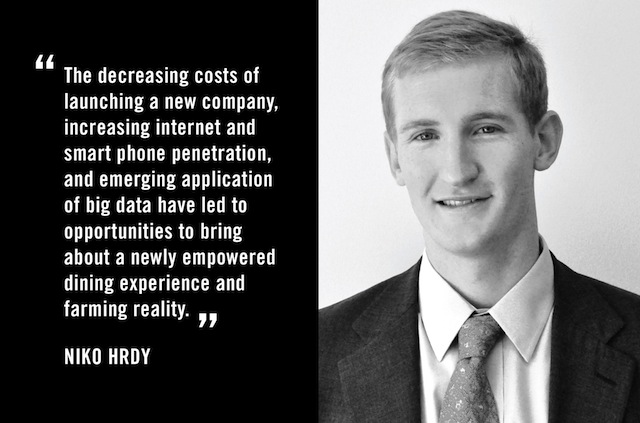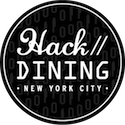Guest post by Niko Hrdy, President at Valley Oak Investments, LP. The views expressed here are solely those of the author and do not reflect the views of Food+Tech Connect.
I grew up on a farm that nestles up against the coastal range on the western side of California’s Central Valley, which spans some of the richest ground in the history of civilization. By rich I don’t mean money-rich. Rather, I mean that provided you can access and apply water, the ground around where I grew up will yield more than 50 tons of tomatoes per acre.
As a boy, I helped my dad by spreading turkey manure in his organic walnut orchards, and when the sheep got loose did my part catching them. It comes naturally for me to visualize where artichokes and arugula are grown and where my lamb chops come from. But this is no longer the typical experience growing up in America. As our society has continued on the path of urbanization, people have lost that connection to the food they eat.
The secret sauce missing from the dining table is understanding where food comes from and what’s really healthy and what’s not. We live in a country where “chicken fingers” count as dinner and children ask: “Daddy, how many fingers does a chicken have?” Assuming you can even read the small print, food labels reads like pages from a chemistry text. Obesity coupled with horrific waste have become the norm, fueled in part by misinformation about which kinds of foods are healthy and why.
At the same time, many of this country’s farmers are co-opted to meet consumer and industry demands that are out of line with the coming demand for healthier produce. Farmers end up planting the highest-yielding seed varietals and using the cheapest and most effective chemical pesticides and herbicides even if some of these practices are neither healthy nor sustainable. This has led to a lack of genetic diversity in our crops and has permanently damaged the environment. There has to be a better way.
I envision a future of dining where consumers—starting young!—are educated about the food they eat: what foods to eat, how the food got on their plate, and how our agriculture and food production systems affect the world in which we live. Do you have a kid who is a picky eater? The best way to get them to eat vegetables is to have them pick, or better yet, grow the lettuce or broccoli themselves. Kids, it turns out, love to be involved in growing and harvesting their own food. Even if that’s not practical, have them join you at your local farmer’s market. Educating diners (the younger the better) is only part of the fight.
We also need better farm-to-fork transparency so consumer choices shape supply. As consumer demand for healthier, more sustainably produced foods grows, farmers are empowered to do what many are already aware that they should do.
There are few industries larger or more vital than the food and agriculture industries, and there has never been a better moment for aspiring entrepreneurs to disrupt these two industries. The decreasing costs of launching a new company, increasing internet and smart phone penetration, and the emerging application of big data have led to opportunities to bring about a newly empowered dining experience and farming reality.
Even with few resources, I anticipate young companies quickly building empires in areas like B2B and B2C marketplaces for sourcing and purchasing food, cloud-based farm management software, or marketplaces for purchasing farm equipment, soil additives, and crop protectants. These companies can be built quickly and at little cost, and yet they will have the power to enact some of the most radical change in this country and secure a better future for the next generation. And so I urge these bold entrepreneurs to think beyond the bottom line and remember that there will be more at stake than just tomorrow’s earnings.
Hacking Dining is online conversation exploring how we might use technology and design to hack a better future for dining. Join the conversation between June 2-30, and share your ideas in the comments, on Twitter using #hackdining, Facebook, LinkedIn or Tumblr.
_________________
Niko grew up on a commercial walnut farm in Northern California that his family still operates today. He is the President of Valley Oak Investments, an investment firm focused on early-stage food, agriculture, and health & wellness companies. He has worked with companies from idea through IPO and prefers taking hands-on roles with the companies he works with.
Niko received an A.B. in economics from Harvard University and is currently pursuing his M.B.A. at the Harvard Business School.





